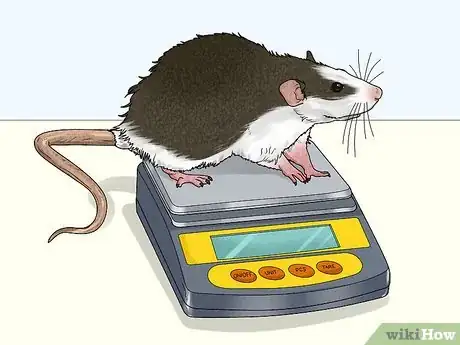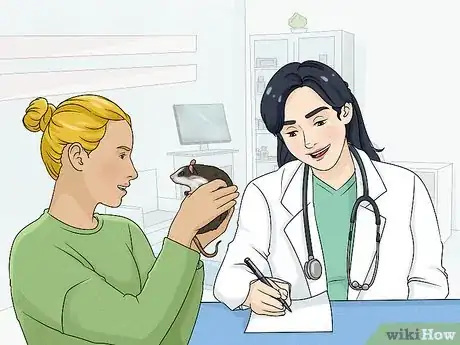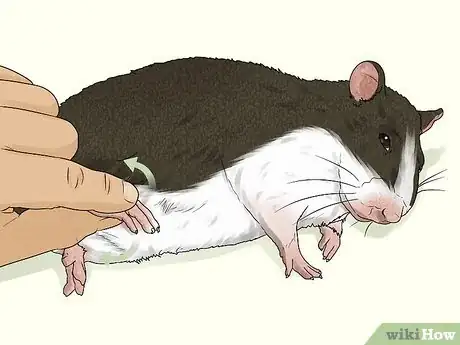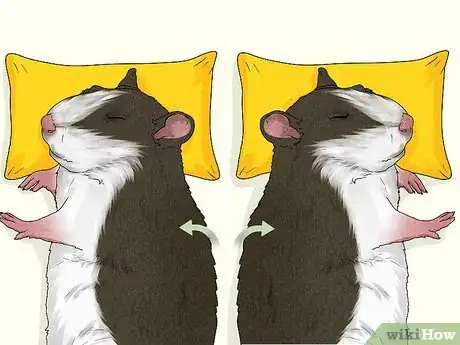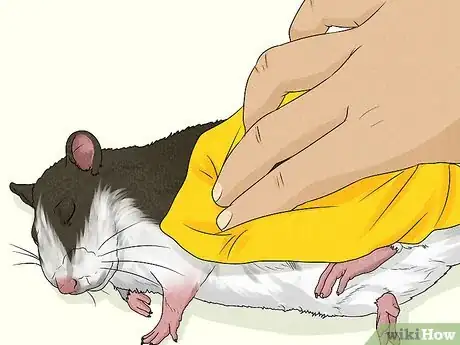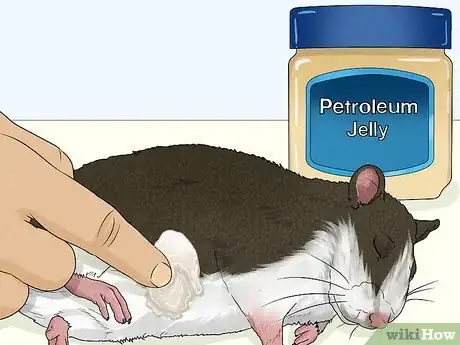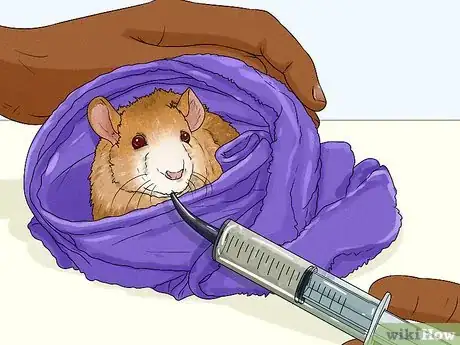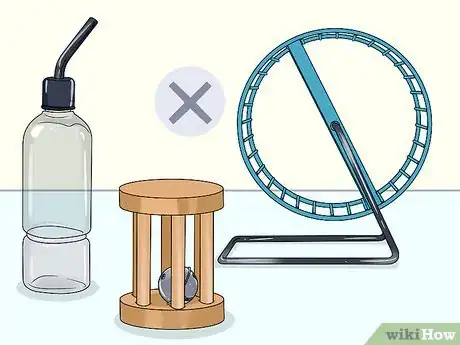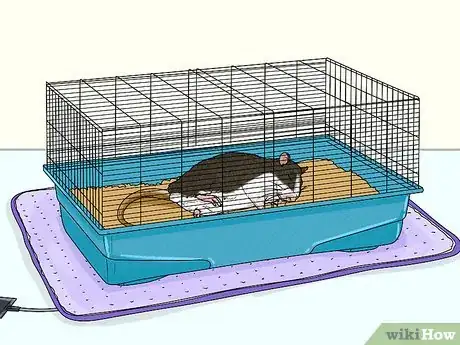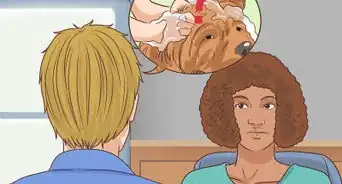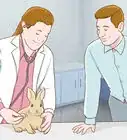This article was co-authored by Pippa Elliott, MRCVS. Dr. Elliott, BVMS, MRCVS is a veterinarian with over 30 years of experience in veterinary surgery and companion animal practice. She graduated from the University of Glasgow in 1987 with a degree in veterinary medicine and surgery. She has worked at the same animal clinic in her hometown for over 20 years.
There are 10 references cited in this article, which can be found at the bottom of the page.
This article has been viewed 22,999 times.
Rats are loving, interactive, and intelligent pets with boundless energy. A rat that has suffered a stroke may recover with proper care and veterinary treatment, in some cases. Keeping your rat healthy, clean, and safe will speed up its recovery from a stroke and get it back to playing quicker.
Steps
Monitoring Your Rat's Health
-
1Weigh your rat twice a day after a suspected stroke. Make sure it is gaining or maintaining its weight, which is a sign it's health is starting to recover. If the rat is losing weight over 24-48 hours, then you need to take it to the vet for a check-up. This is a sign that the rat is not recovering.
- The vet can recommend the best treatment for your rat. In some cases, they may recommend helping the rat pass.
-
2Check your rat for dehydration by lifting its scruff. Gently pull up on the scruff of your rat's neck, then let it go. The skin should immediately go back into place. If it doesn't, then your rat is dehydrated.
- Keep in mind that a dehydrated rat will feel ill, so it's important you get it immediate treatment.
Advertisement -
3Follow all of your vet's treatment instructions. Your vet will likely give you a treatment plan for your rat. As you care for the rat, continue to work with your vet to make sure your rat gets the best care possible. It's important that you not try to treat your rat on your own.
- If the rat is not recovering, your vet will likely recommend euthanizing it. Although this is a very difficult decision, it's sometimes best to let the rat go so it won't suffer.
Assisting with Exercise and Hygiene
-
1Conduct gentle physical therapy for your rat. Moving the rat's legs and head up and down and side to side when it cannot move on its own will keep the body parts limber and build muscles to keep them from becoming atrophied. Move the body in a natural way using your index finger and thumb every few hours to maintain muscles and flexibility.
- While major motor functions will likely remain damaged, physical therapy and exercise can improve your rat's physical functions. [1]
- Physical therapy is not a replacement for medications from the veterinarian. Be sure to give those as well.
- Stroke your rat's back to get it to play or engage with you.[2]
-
2Move the rat every hour to help prevent sores from developing. Bed sores, or pressure ulcers, can occur when the rat remains in the same place for too long. With a stroke, your rat may be unconscious, suffer from paralysis, or be too lethargic to move on its own. That is when bed sores can form.
- Bed sores can form on any part of the rat's body that is pressed against the cage or bedding material for too long.
- Look for red, sore places that eventually turn purple.
- If untreated or prevented, bed sores can cause dangerous infections.[3]
- Wash any bed sores with betadine, diluted to the color of strong iced tea two times per day.[4]
-
3Clean your rat when it gets dirty. Use a warm cloth and water for most daily hygiene on any parts of the rat that are soiled from daily functions. Non-abrasive soap can be added if crust forms around an area or it is too dirty for just water to remove.
- Daily bathing will help prevent infections.[5] Keep the rat clean at all times. If it soils itself, bathe it immediately so it remains clean.
- For an open wound, washing with saline solution will flush out debris.
- Wash your hands before cleaning your rat to avoid passing any infection to your rat. It also keeps you from catching something, too.[6]
-
4Apply petroleum jelly or Sudocrem to the rat to protect from urine burn. Re-apply the cream after each bath you give the rat. This will protect the rat from discomfort and health complications caused by possible urine burn.
- You can find these creams at a pet store, drug store, or online.
Feeding Your Injured Rat
-
1Secure your rat for feeding in a towel. A soft towel will keep your rat from getting too cold during the feeding. Gently yet securely wrap the rat in the towel to make sure it can't squirm free.
- Holding your rat upright keeps it from choking.[7]
- After a stroke, it might be hard for your rat to maintain its body temperature. The towel will help keep it warm.
- Cradling your rat against your chest can be a bonding experience. Your rat may know that you're helping it.
-
2Prepare the food mixture. Mix one part soy-based infant formula, two parts baby oatmeal, and enough warm water to turn the mixture into the thickness of pancake batter. Fill a 1 milliliter (0.034 fl oz) syringe to the 1.0 line.
- Add enough water to make the mixture liquid if your rat is unable to drink on its own.
- Normal oatmeal will be too hard for your rat to digest.
- This mixture will be their food and water while they recover.[8]
-
3Squeeze the food mixture into your rat's cheek. Slowly push the mixture out of the syringe and into your rat's cheek or the front part of its mouth to prevent choking. This will give your rat a chance to work on eating for itself as well.
- Watch to make sure your rat swallows the food.
- Allow your rat to lick the syringe if it wants to. Some rats enjoy being fed by hand.
- A 1 pound rat should consume around 10 syringes of mixture at each feeding, four times per day.[9]
Keeping a Safe Cage
-
1Remove dangerous objects to keep your rat safe. Wheels, water bottles, open water sources, and large toys can be a hazard to an injured or convulsing rat. Keep these away from your rat until it is fully recovered and able to use them normally.
- Open water sources pose a drowning risk.
- Keep your rat from getting too close to wire cage walls. Paralyzed feet can get caught between the bars.
- Use physical therapy by moving your rat's legs and body instead of letting it play to help prevent further injuries.[10]
-
2Clean your rat's cage to prevent infections, hair loss, and sickness. Remove and replace soiled bedding daily. Scrub the cage with baby wipes for dirty spots every day and wash the entire cage with white vinegar once a week.
- Proper cleaning of bedding and the cage itself with baby wipes or white vinegar will help your rat's recovery and reduce lethargy.
- Remove any spoiled food so your rat doesn't try to eat it.
- Any change in your rat's routine can result in hair loss. This should get better with stroke recovery.[11]
- Your rat may experience increased lethargy from being in a dirty cage. Keeping it clean will encourage it to recover so it can play again.
-
3Keep your rat's cage away from extreme temperatures. Changes in temperatures, both hot and cold, can pose a threat to your recovering rat while it is unable to move away from a hot source or run around to heat itself in the cold.
- Following a stroke, your rat may not be able to move enough to keep up its body temperature.
- If hair loss occurs, your rat will be more susceptible to the cold. Look for signs of shivering or lethargy.
- Move your rat away from heat sources if it develops a hunched appearance or refuses to drink water. These are signs of dehydration.[12]
- Use a heating pad to keep your rat from getting too cold in a drafty area.[13]
References
- ↑ https://www.sciencedaily.com/releases/2014/06/140612142346.htm
- ↑ https://www.cuteness.com/article/signs-stroke-rats
- ↑ https://www.hopkinsmedicine.org/healthlibrary/conditions/dermatology/bedsores_85,P00260
- ↑ http://www.organic-pet-digest.com/horrible-open-sore-on-pet-rat.html
- ↑ http://ratguide.com/health/neurological/stroke.php
- ↑ http://ratguide.com/health/trauma/wounds.php
- ↑ https://www.tinytoesratrescue.org/food
- ↑ https://www.tinytoesratrescue.org/food
- ↑ https://www.tinytoesratrescue.org/food
